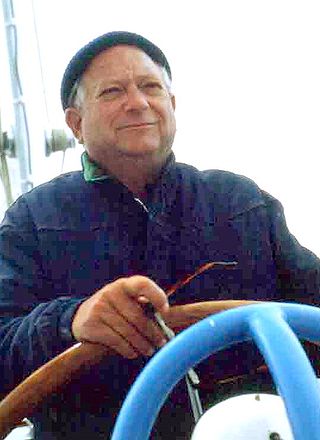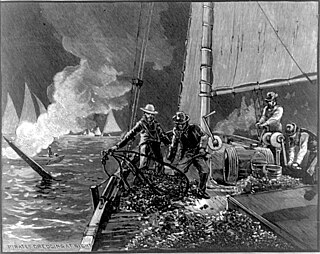
John Griffith Chaney, better known as Jack London, was an American novelist, journalist and activist. A pioneer of commercial fiction and American magazines, he was one of the first American authors to become an international celebrity and earn a large fortune from writing. He was also an innovator in the genre that would later become known as science fiction.

John Holbrook Vance was an American mystery, fantasy, and science fiction writer. Though most of his work has been published under the name Jack Vance, he also wrote several mystery novels under pen names.

Oyster pirate is a name given to persons who engage in the poaching of oysters. It was a term that became popular on both the West Coast of the United States and the East Coast of the United States during the 19th century.

His Last Bow: Some Reminiscences of Sherlock Holmes is a 1917 collection of previously published Sherlock Holmes stories by British writer Arthur Conan Doyle, including the titular short story, "His Last Bow. The War Service of Sherlock Holmes" (1917). The collection's first US edition adjusts the anthology's subtitle to Some Later Reminiscences of Sherlock Holmes. All editions contain a brief preface, by "John H. Watson, M.D.", that assures readers that as of the date of publication Holmes is long retired from his profession of detective but is still alive and well, albeit suffering from a touch of rheumatism.

George Sterling was an American writer based in the San Francisco, California Bay Area and Carmel-by-the-Sea. He was considered a prominent poet and playwright and proponent of Bohemianism during the first quarter of the twentieth century. His work was admired by writers as diverse as Ambrose Bierce, Robinson Jeffers, Jack London, Upton Sinclair, Theodore Dreiser, Sinclair Lewis, and Clark Ashton Smith.

Arnold Genthe was a German-American photographer, best known for his photographs of San Francisco's Chinatown, the 1906 San Francisco earthquake, and his portraits of noted people, from politicians and socialites to literary figures and entertainment celebrities.

The Cliff House is a neo-classical style building perched on the headland above the cliffs just north of Ocean Beach, in the Outer Richmond neighborhood of San Francisco, California. The building overlooks the site of the Sutro Baths ruins, Seal Rocks, and is part of the Golden Gate National Recreation Area, operated by the National Park Service (NPS). The Cliff House is owned by the NPS; the building's terrace hosts a room-sized camera obscura.

Jack Micheline, born Harold Martin Silver, was an American painter and poet from the San Francisco Bay Area. One of San Francisco's original Beat poets, he was an innovative artist who was active in the San Francisco Poetry Renaissance of the 1950s and 1960s.

James Marie Hopper was an American writer and novelist. He was also an early college football player and coach, playing at the University of California, Berkeley in the late 1890s and then serving single seasons as head football coach at Nevada State University—now known as the University of Nevada, Reno—in 1900 and at his alma mater, California, in 1904. During his lifetime, Hopper published 450 short stories and six novels.

At 05:12 Pacific Standard Time on Wednesday, April 18, 1906, the coast of Northern California was struck by a major earthquake with an estimated moment magnitude of 7.9 and a maximum Mercalli intensity of XI (Extreme). High-intensity shaking was felt from Eureka on the North Coast to the Salinas Valley, an agricultural region to the south of the San Francisco Bay Area. Devastating fires soon broke out in San Francisco and lasted for several days. More than 3,000 people died, and over 80% of the city was destroyed. The event is remembered as the deadliest earthquake in the history of the United States. The death toll remains the greatest loss of life from a natural disaster in California's history and high on the lists of American disasters.
Jacob Anderson-Minshall is an American author.

John Joseph "Jack" Fritscher is an American author, university professor, historian, and social activist known internationally for his fiction, erotica and non-fiction analyses of popular culture and gay male culture. A pre-Stonewall riots activist, he was an out and founding member of the Journal of Popular Culture. Fritscher was the founding San Francisco editor-in-chief of Drummer magazine.

Rodger Jacobs was an American journalist, writer, author, film producer, columnist, playwright, editor and screenwriter.
Gary Edson Arlington was an American retailer, artist, editor, and publisher, who became a key figure in the underground comix movement of the 1960s and 1970s. As owner of one of America's first comic book stores, the San Francisco Comic Book Company, located in San Francisco's Mission District, Arlington's establishment became a focal point for the Bay Area's underground artists. He published comics under the name San Francisco Comic Book Company, as well as publishing and distributing comics under the name Eric Fromm. Cartoonist Robert Crumb has noted, "Gary made a cultural contribution in San Francisco in the late 1960s, through the '70s, '80s & '90s that was more significant than he realizes."
Drummer is an American magazine which focuses on "leathersex, leatherwear, leather and rubber gear, S&M, bondage and discipline, erotic styles and techniques." The magazine was launched in 1975 and ceased publication in April 1999 with issue 214, but was relaunched 20 years later by new publisher Jack MacCullum with editor Mike Miksche.
"The South of the Slot" is a short story by American naturalist writer Jack London (1876–1916). It was first published in The Saturday Evening Post, Vol. 181, May, 1909. In 1914, it was published by Macmillan in a collection of Jack London’s stories, The Strength of the Strong. The title of the story refers to a location in San Francisco, which is now called SOMA, or South of Market.

The Cruise of the Dazzler is an early novel by Jack London, set in his home city of San Francisco. It is considered a boy's adventure novel.
Julien Poirier is an American poet born in the San Francisco Bay Area. He is the author of several poetry collections, and the editor of an anthology of writing and a book of travel journals.

San Francisco Comic Book was an underground comix anthology published between 1970 and 1983. Conceived of and edited by Gary Arlington, the anthology highlighted the work of many of San Francisco's top underground talents, including Bill Griffith, Robert Crumb, Kim Deitch, Justin Green, Rory Hayes, Willy Murphy, Jim Osborne, Trina Robbins, and Spain Rodriguez.
Stella Wynne Herron was an American writer and suffragist whose work appeared in a variety of magazines, including Collier's, Sunset, and Weird Tales. She is most known for her 1916 short story "Shoes", which pioneering film director Lois Weber adapted into a film of the same name. The film is now considered a feminist classic in early cinema history.














